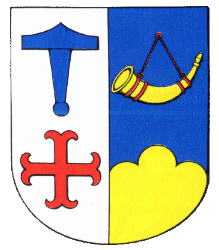Ishøj: Difference between revisions
Jump to navigation
Jump to search
Knorrepoes (talk | contribs) m (Text replace - "'''Origin/meaning :'''<br/>" to "====Origin/meaning====") |
Knorrepoes (talk | contribs) m (Text replace - "[[Literature" to "{{media}} [[Literature") |
||
| Line 18: | Line 18: | ||
The hammer is the hammer of Thor and was canting for Thorslunde. The golden hills ('høj') are canting for Ishøj. The cross is derived from an old cross in the local graveyard and the horn symbolises the fact for many centuries there has been some Royal hunting grounds in the municipality. | The hammer is the hammer of Thor and was canting for Thorslunde. The golden hills ('høj') are canting for Ishøj. The cross is derived from an old cross in the local graveyard and the horn symbolises the fact for many centuries there has been some Royal hunting grounds in the municipality. | ||
{{media}} | |||
[[Literature]] : Achen, 1982 | [[Literature]] : Achen, 1982 | ||
[[Category:Denmark]] | [[Category:Denmark]] | ||
[[Category:Granted 1953]] | [[Category:Granted 1953]] | ||
Revision as of 23:22, 8 July 2014
| Heraldry of the World Civic heraldry of Denmark - Danmarks Kommunevåbener |
ISHØJ (until 1978 Thorslunde-Ishøj)
Region : Hovedstaden
Amt (until 2007) : København
Origin/meaning
The arms were devised in 1953 for Thorslunde-Ishøj municipality, which changed its name in 1978 to Ishøj.
The hammer is the hammer of Thor and was canting for Thorslunde. The golden hills ('høj') are canting for Ishøj. The cross is derived from an old cross in the local graveyard and the horn symbolises the fact for many centuries there has been some Royal hunting grounds in the municipality.
Contact and Support
Partners:
Your logo here ?
Contact us
© since 1995, Heraldry of the World, Ralf Hartemink 
Index of the site
Literature : Achen, 1982











